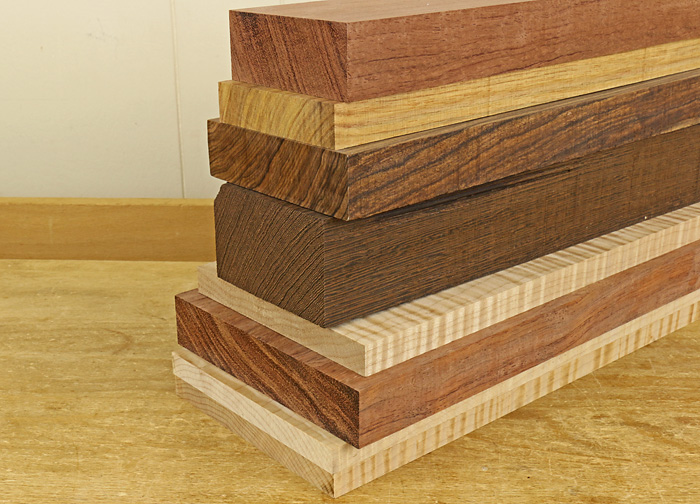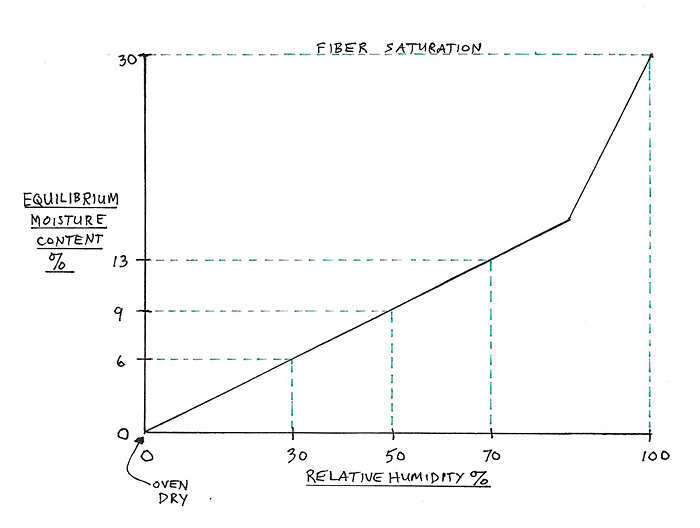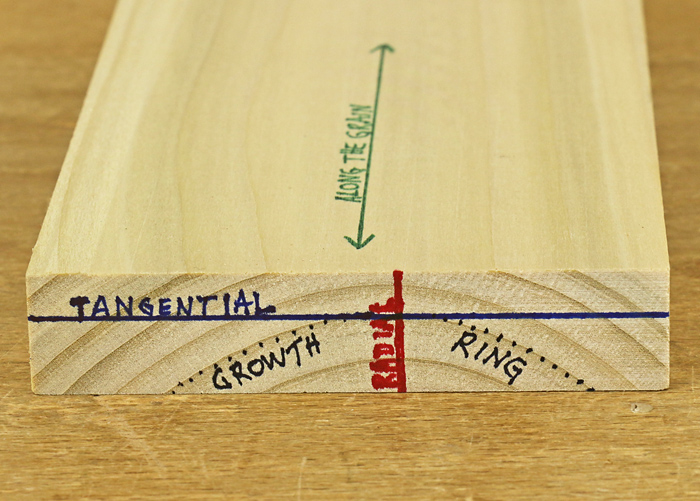Understanding how wood moves as it exchanges moisture with the air is some of the most important knowledge a woodworker can have. Here is lifetime information for all woodworkers.

Start with a tree
Chop down a tree, saw out a chunk of wood, and pick it up. Depending on the species, one-third to one-half of the weight in your hands is water. Most of the water is free in the spaces between the wood cells (fibers), while the remainder is in the cell walls of the fibers.
When the free water is removed by drying, the fibers remain saturated. In this way, 10 pounds of dry wood typically holds 3 pounds of water. This is referred to as a wood moisture content (MC) of 30%. MC% = (weight of the water/dry weight of the wood) x 100.
Proceeding from the fiber saturation point, the water in the fibers exits as the wood continues to dry. As it dries, the wood shrinks. If you put the piece of wood in an oven (not recommended), the drying and shrinking would continue until there is 0% MC, meaning there is no water at all in the wood.
Exchange and equilibrium
Between 0% and 30% MC, wood continually adjusts to the humidity of the surrounding air, seeking equilibrium. At each level of relative humidity (RH), which is a number we are familiar with from weather reports, the wood will have a certain equilibrium moisture content. For example, when the RH is 50%, an average species of wood has about 9% MC.
If the RH is lowered to 30%, the wood will loose water until it reaches a MC of 6%, and in doing so, it shrinks. If the RH is raised to 70%, the wood will regain water until it reaches a MC of 13% and it will swell as it does so.
The simplified graph below shows the equilibrium moisture content of a typical species of wood over the full range of air humidity.

This, in summary, is wood movement: wood shrinks and swells as its moisture content changes. The moisture content of wood changes in response to changes in the humidity of the air. It is a continual process.
Wood movement and grain orientation
Here is the big issue in understanding wood movement: it differs greatly according to the grain orientation. These principles apply to all species of wood. Marked on the board in the photo are three dimensions:

1. Along the grain, also called longitudinal, marked in green. This simply means along the length of the wood fibers and is irrespective of whether the direction is “with the grain” or “against the grain,” issues not germane to this discussion. Wood movement is negligible along the grain.
The next two are across the grain but in different directions.
2. Tangential to the annual growth rings, marked in blue. The dimension is really along the curve of the growth rings but since wood is usually cut in a rectangle, the practical dimension is a line tangent to a growth ring.
3. Radial to the growth rings, marked in red. Think of this dimension as a radius line coming out from the center of the tree to the bark. It crosses the tangential dimension at a 90° angle.
Now here are one of the most important facts in the world of wood:
It turns out that wood movement – shrinking and swelling – is for most species about twice as much along the tangential dimension as along the radial dimension. For example, a board of sugar maple with fully water-saturated fibers that is oven dried to remove all of the water will shrink about 10% of its tangential dimension and 5% of its radial dimension.

This all leads to two big issues
1. The differential in wood movement according to grain direction has great implications for how to select wood in general and how to build with it to make projects that will last.
2. Furthermore, the amount of overall wood movement and the differential between tangential and radial movement vary greatly among wood species. This is critical to choosing wood species and knowing how to adjust your designs and techniques to the choice.
We’ll explore these two issues in depth in an upcoming post.
You might also enjoy our post on minimizing the effects of wood movement.

Share tips, start a discussion or ask one of our experts or other students a question.
No Responses to “Understanding and Calculating Wood Movement”